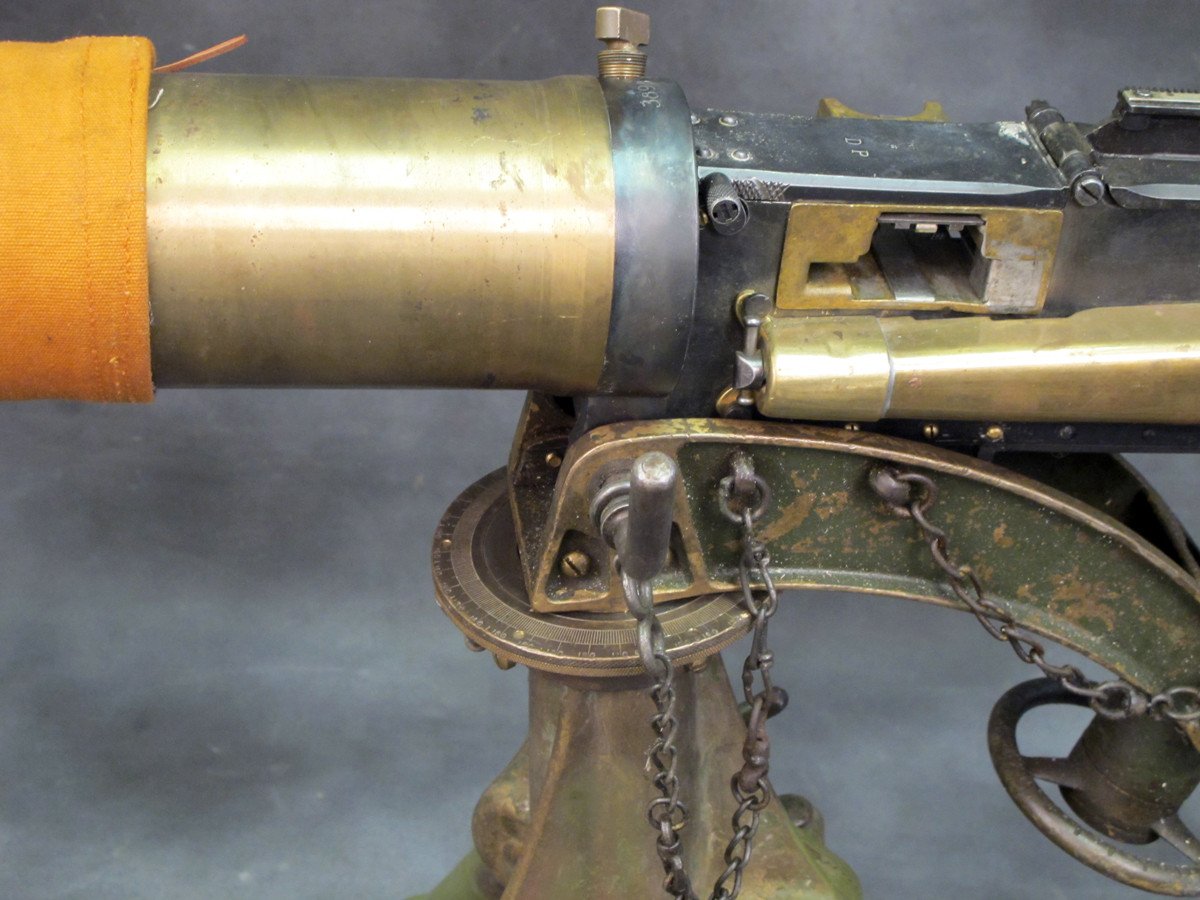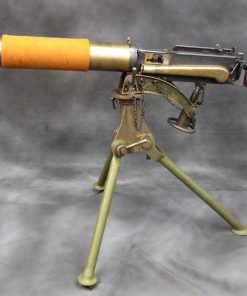British WWII Vickers Jungle Issue Display Machine Gun with Tripod Original Items
$ 2.995,00 $ 748,75
Original Item: Only One Available. The war against the Japanese started on December 7th 1941 and no sooner had the Japanese hit Pearl Harbor than their land forces invaded British South East Asia including Malaya.
The British took a real beating and lost almost all it’s Colonial possessions to the Japanese right up to the “Gates of India”. Jungle Warfare, especially in the tropics of Burma and Malaya provided the British with a completely new range of problems not least of which was the tremendous damp and humidity which destroyed all types of equipment very quickly.
Experimentally considered was the use of Brass in Vicker’s M.G. construction specifically for the Water Jackets but also other components such as the Fusee Spring Covers however many ideas never got off “the drawing board” as advances in tactics and technology often made the “improvements” redundant. Such was the fate of the Brass Jacketed Vickers Gun. However IMA has reconstructed some sample components of what was proposed and here is a complete Vickers Jungle Fighting Display Gun.
This is a one-of-akind WWII era Vickers machine gun with the desirable early WWII pattern all brass smooth water jacket. Using an early parts set we have built a stunning non-firing WW2 display Machine gun and mounted it on an original rare tripod mount.
Built with new made, BATF approved, steel dummy receiver plates incorporating most of the internal moving parts these non-guns are totally legal to own without any federal restrictions. Beautifully machined, this makes a magnificent display that would fool most experts. Complete with original tripod.
The Vickers machine gun or Vickers gun is a name primarily used to refer to the water-cooled .303 inch (7.7 mm) machine gun produced by Vickers Limited, originally for the British Army. The machine gun typically required a six to eight-man team to operate: one to fire, one to feed the ammunition, the rest to help carry the weapon, its ammunition and spare parts. It was in service from before the First World War until the 1960s.
The weapon had a reputation for great solidity and reliability. Ian V. Hogg, in Weapons & War Machines, describes an action that took place in August 1916, during which the British Army’s 100th Company of the Machine Gun Corps fired their ten Vickers guns continuously for twelve hours. Using 100 new barrels, they fired a million rounds without a single breakdown. “It was this absolute foolproof reliability which endeared the Vickers to every British soldier who ever fired one.”
The Vickers machine gun was based on the successful Maxim gun of the late 19th century. After purchasing the Maxim Company outright in 1896, Vickers took the design of the Maxim gun and improved it, reducing its weight by lightening and simplifying the action and substituting components made with high strength alloys. A muzzle booster was also added.
The British Army formally adopted the Vickers gun as its standard machine gun on 26 November 1912, using it alongside their Maxims. There were still great shortages when the First World War began, and the British Expeditionary Force was still equipped with Maxims when sent to France in 1914. Vickers was, in fact, threatened with prosecution for war profiteering, due to the exorbitant price it was demanding for each gun. As a result, the price was slashed. As the war progressed, and numbers increased, it became the British Army’s primary machine gun, and served on all fronts during the conflict. When the Lewis Gun was adopted as a light machine gun and issued to infantry units, the Vickers guns were redefined as heavy machine guns, withdrawn from infantry units, and grouped in the hands of the new Machine Gun Corps.
After the First World War, the Machine Gun Corps (MGC) was disbanded and the Vickers returned to infantry units. Before the Second World War, there were plans to replace the Vickers gun; one of the contenders was the 7.92 mm (.312 in) Besa machine gun (a Czech design), which eventually became the British Army’s standard tank-mounted machine gun. However, the Vickers remained in service with the British Army until 30 March 1968. Its last operational use was in the Radfan during the Aden Emergency.
Prompt Shipping and Professional Packaging
We provide a variety of shipping options due to our long-running partnerships with UPS, FedEx and DHL. Our warehouse personnel are well trained and will pack the goods according to our exact and precise specifications. Before shipping your items will be thoroughly inspected and secured. Every day, we deliver to thousands of customers in different countries. This is a sign of our determination to become the largest online retailer worldwide. Both Europe as well as the USA have warehouses and distribution centers.
Note that orders containing more than one item will be subject to a processing period that is based to the particular item.
Prior to shipping the items, our staff will carry out an exhaustive inspection of the products you ordered. Today, most orders will be delivered within 48 hours. The estimated delivery time is between 3-7 days.
Returns
The stock is constantly changing. It's not entirely managed by us since we are involved with multiple entities, including the factory and our storage. Therefore, the actual inventory could alter at any time. It is possible that you will not receive your order after the order has been made.
The period of time is 30 days. Unfortunately, if 30 days have passed since you purchased your product, we are unable to provide a refund or exchange.
The item must not be in use and must be in the original packaging. The item must be in the original packaging.
Related products
Uncategorized
Uncategorized
Uncategorized
Uncategorized
Uncategorized
Uncategorized
Uncategorized
Band of Brothers ORIGINAL GERMAN WWII Le. F.H. 18 10.5cm ARTILLERY PIECE Original Items
Uncategorized
Uncategorized
Uncategorized
Armored Burgonet Helmet & Polearm from Scottish Castle Leith Hall Circa 1700 Original Items
Uncategorized
Uncategorized
Uncategorized
Australian WWII Owen MK1 Machine Carbine SMG Custom Fabricated Replica with Sling Original Items
Uncategorized
Uncategorized
Uncategorized
Uncategorized
Armoured Fighting Vehicles of the World: AFVs of World War One (Hardcover Book) New Made Items












































































